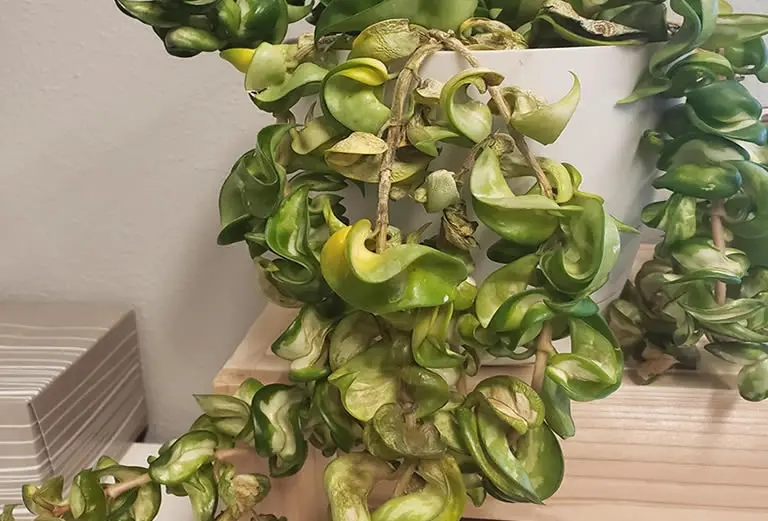The Hindu rope plant is a truly unique houseplant. When properly cared for it’s hanging vines can reach up to 6 feet in length and its yearly blooms are a beautiful pink. However, due to its unique nature, this vine often causes confusion when it comes to the plant’s care routine and this, in turn, leads to problems with the plant. So, in this article I will cover the 5 common problems that Hindu rope plant owners experience with this semi-succulent and their quick fixes.
Table of Contents
- Common Hindu rope plant problems & their fixes
- Causes & fixes for Hindu rope plant yellow leaves
- The 8 causes for a Hindu rope plant turning yellow
- The easy fixes for a Hindu rope plant turning yellow
- Hindu rope plant yellow leaves cause & cure 1: Overwatering
- Hindu rope plant yellow leaves cause & cure 2: Poorly draining soil with inadequate airflow
- Hindu rope plant yellow leaves cause & cure 3: Low Humidity
- Hindu rope plant yellow leaves cause & cure 4: Temperature stress
- Hindu rope plant yellow leaves cause & cure 5: Incorrect lighting
- Hindu rope plant yellow leaves cause & cure 6: Pests
- Hindu rope plant yellow leaves cause & cure 7: Disease
- Hindu rope plant yellow leaves cause & cure 8: Old age
- Causes & fixes for Hindu rope plant leaves falling off
- Causes & fixes for a Hindu rope plant shriveling with wrinkled leaves
- Causes & fixes for a Hindu rope plant with dry leaves
- Causes & fixes for Hindu rope plant not blooming
Common Hindu rope plant problems & their fixes
There are 5 common problems that are encountered with Hindu rope plants that are grown indoors.
Although there are only 5 problems, each of these problems can be caused by one or more of several different things.
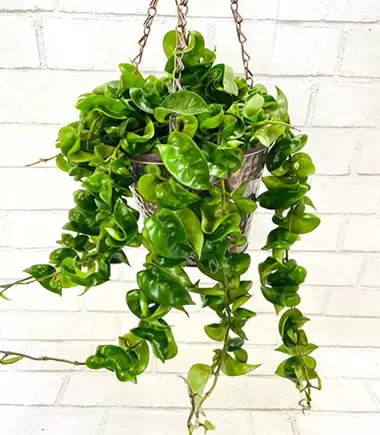
I have covered each of the causes for each of the 5 potential problems your plant may face.
In this article I have included both issues that arise from a poor care routine and also problems that come from pests and diseases.
Although there can be problems that occur with a Hindu rope plant that are beyond the control of the owner, such as pest infestations, the vast majority of problems are due to an incorrect care routine.
This is actually great news for you if you own a Hindu rope plant that is currently experiencing problems, because if you are the cause of those problems then you can also be the cure.
Once you have identified the cause of your Hindu rope plant problem and taken the recommended steps to treat your plant I highly recommend you read our Hindu rope plant care guide.
By following the advice in that article you will avoid encountering any future problems with your plant.
The 5 common Hindu rope plant problems are:
- Yellowing leaves.
- Leaves falling off.
- Shriveling plant with wrinkled leaves.
- Dry leaves.
- Non-blooms.
Below I have covered in detail all the causes for these 5 very common problems Hindu rope houseplants face and given you an easy solution for each one.
Causes & fixes for Hindu rope plant yellow leaves
Yellow leaves on a Hindu rope plant are, arguably, the most common problem encountered by houseplant owners.
It can be disheartening when your precious Hoya carnosa starts turning yellow.
This is not just because it takes away from the look of that distinctive foliage but largely because it took you so long to grow it.
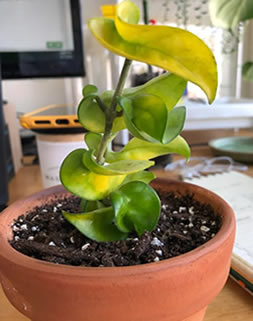
In order to treat the plant you must first determine why its leaves are turning yellow.
There are can several reasons for a Hindu rope plant turning yellow and therefore several fixes to the problem.
Let’ look at those causes now.
The 8 causes for a Hindu rope plant turning yellow
Below are the 8 main reasons for a Hindu rope plant turning yellow:
- Overwatering.
- Poorly draining soil with inadequate airflow.
- Low humidity levels.
- Temperature stress.
- Incorrect lighting.
- Pests.
- Disease.
- Old age.
The only way to identify the primary cause for the leaf yellowing is to investigate the growing conditions of the plant.
As you read through the fixes below, for each potential cause of the yellowing foliage, it will become apparent how you can identify which cause is at the root of your plant’s problem.
The easy fixes for a Hindu rope plant turning yellow
Follow the advice below to fix the problem that you have identified as the cause for the yellowing of your Hindu rope plant.
Hindu rope plant yellow leaves cause & cure 1: Overwatering
By far the most serious problem a Hindu rope plant can face is the damage done by overwatering.
Overwatering is detrimental to all plants but succulents and semi-succulents are most at risk of suffering irreparable damage if you have been too heavy-handed with the watering can.
As a semi-succulent your Hoya carnosa compacta Hindu rope plant should never be left to sit in drenched soil.
Too much water in the soil and the roots will rot.
When root rot occurs the plant literally dies of dehydration while sitting in an abundance of water.
Although this seems counterintuitive it makes perfect sense when you consider what root rot is and what it does to the plant.
Root rot is exactly what the name implies; the roots of the plant rot away.
As the roots rot they become unable to absorb moisture from the soil so they can distribute it to the rest of the plant.
As water is also responsible for carrying nutrients to the outer foliage the plant also suffers from lack of food.
Hence, the visible parts of the plant display signs of dehydration even though there is plenty of moisture in the soil.
The only way to identify root rot is to remove your Hindu rope plant from its pot.
Shake away the soil from the rootball and visually examine the roots.
If they are mushy and black then the plant has root rot.
When a Hindu rope plant has root rot you must act immediately.
Trim away all the dead roots and repot the plant in fresh soil.
Reduce your watering routine dramatically until you see a recovery in the plant and then only water the plant when the soil is dry.
Use a moisture meter and push the meter down into the soil to a depth of at least 2 inches.
Water the plant when the meter reads “dry”.
For detailed instructions on how to treat root rot read our article on aloe vera root rot – the instructions for treating Hindu rope plant root rot are identical.
Hindu rope plant yellow leaves cause & cure 2: Poorly draining soil with inadequate airflow
The Hindu rope plant requires a well-draining soil that allows for good airflow to the roots.
As you seen above, this plant does not react well to sitting in standing water.
It needs soil that drains away excess water quickly but the soil also need to promote good airflow.
Being epiphytic (requiring another plant in order to grow) in its native habitat, the Hindu rope plant is commonly seen hanging from trees.
The plant nestles itself into the crevices of trees where it grows and where its roots get plenty of air.
As you are growing your Hoya carnosa as a houseplant you must try to replicate those conditions as best you can even though your plant will be in a pot or basket.
You do that by planting the vine in a very specific type of soil.
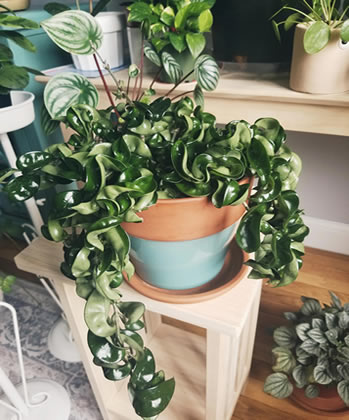
If the Hindu rope plant is not growing in soil that is fast-draining and that promotes very good airflow the foliage can suffer and start to turn yellow.
Be sure the soil you are using for your Hoya is 1 part potting mix and 1 part perlite.
This offers the semi-succulent all the nutritional support it needs while ensuring the roots get excess to good airflow while excess moisture is simultaneously drained away.
Hindu rope plant yellow leaves cause & cure 3: Low Humidity
Being a tropical vine Hoya carnosa compacta has evolved to thrive in high humidity.
Although the average home offers the plant adequate warmth it does not provide the much-needed high humidity that the Hindu rope plant requires to grow.
Low humidity levels can lead to leaf yellowing and the stunted growth of the plant.
If you have been relying on misting alone to increase the humidity around your Hindu rope plant you will probably have found it has been mostly ineffective.
Placing a tray with pebbles and water underneath the plant can help, as can the use of a terracotta pot.
The best option by far though is to use a cheap plant humidifier, like this, as it will easily create humidity levels of 40% – 60% directly around the plant without causing a rise in the overall humidity levels of the room.
Hindu rope plant yellow leaves cause & cure 4: Temperature stress
Hoya carnosa compacta grows naturally in a tropical climate that not only experiences high humidity levels, but that also has fairly high temperatures (see how do Hoya plants grow).
Thus the Hindu rope plant prefers to be in warm environments.
This Hoya prefers temperatures in the range of 65°F – 80°F.
If you are keeping your semi-succulent somewhere that gets temperatures below 50°F the foliage will suffer and may begin to show signs of cold stress.
Leaves can turn yellow before eventually dying.
Because the average home has fairly consistent temperatures of around 70°F, the Hindu rope plant usually has no problem being grown as a houseplant.
But, if you have placed your plant somewhere that gets drafts or extreme dips in temperature it will negatively react and show its distress through its foliage.
So, avoid placing your Hindu rope plant near drafty doors, windows or appliances like freezers.
Likewise, you should avoid placing your Hindu rope plant anywhere that gets temperatures above 80°F and also avoid areas that get bursts of heat, like heating vents.
Regularly check the temperature of the location where you have placed your plant and move it if you notice large temperature swings throughout the day or at night.
Hindu rope plant yellow leaves cause & cure 5: Incorrect lighting
Probably the most common reason for a yellowing of Hoya leaves is incorrect lighting.
Although low light is less likely to cause a yellowing of the leaves (it is more likely to result in extremely stunted growth) excess light will almost definitely create this problem in your plant.
The yellowing effect occurs on the foliage due to strong direct light bleaching the leaves.
If you have placed your Hindu rope plant in the path of direct light you should move it immediately.
This Hoya prefers at least 4 hours of strong indirect light.
Place the plant somewhere that is away from a sun-facing window but that gets good lighting throughout the day.
If need be, you can use a grow light if the only only locations available are gloomy or dimly lit.
A grow light is always preferable over direct sunlight!
Hindu rope plant yellow leaves cause & cure 6: Pests
Hoyas are fairly pest-resistant plants so an infestation of pests is the lest likely culprit for yellowing leaves. It is a possibility though.
Check your plant for signs of bugs and their eggs.
Common bugs include spider mites, thrips, mealybugs and aphids.
A clear sign of a pest infestation, apart from obvious pests and their eggs, is sporadic leaf yellowing rather than the entire leaf turning yellow.
Regardless of what species of pest that is attacking your plant a good organic insecticide, formulated for indoor or outdoor use (it doesn’t matter), will be more than enough to deal with this problem.
Many indoor gardeners will spray their houseplants once per year with an organic insecticide as it does no harm to the plant and prevents a pest infestation.
Do not take this approach with a chemical pesticide as the chemicals in the mixture can infiltrate the soil and affect the plant’s growth.
Non-organic sprays should only be used when there is a very serious infestation.
Hindu rope plant yellow leaves cause & cure 7: Disease
All plants are susceptible to disease.
However, your Hindu rope plant is much more resilient to disease than most of your other houseplants in large degree due to the protection provided by its wax-like cuticle.
Having said that, this curly wax plant is not immune to disease.
With the Hoya carnosa most diseases will actually develop due to an incorrect watering routine more than anything else.
Along with yellow leaves you will often find leaves with yellow spots, brown spots or black spots.
This is an indication of root damage and you must treat the plant with a good fungicide.
Also check the plant for root rot!
It is also advisable to isolate any plant with a disease from other plants in your home until it fully recovers.
You may want to repot the plant, in a new pot with fresh soil, after treatment once it shows clear signs of recovery.
Clean and dispose of the old pot.
Hindu rope plant yellow leaves cause & cure 8: Old age
When foliage ages on a Hoya it tends to turn yellow before falling off the plant.
This is completely natural and the odd yellow leaf is to be expected.
You can trim away these dying leaves to maintain the aesthesis of your plant if you wish.
Unfortunately all things grow old and eventually die.
A Hindu rope houseplant will live for up top 30 years and will grow vines up to 6 feet in length (26 feet in the wild) before it starts to decline.
When the plant has entered old age it will find it more difficult to maintain good pigmentation on its foliage.
You will see more and more yellowing of the leaves until the plant eventually dies.
For information on yellow leaves on other Hoya plants read the article why are my Hoya leaves yellow.
Propagating a new plant from your existing Hindu rope plant that is sufferings from old age is a great way to preserve your houseplant.
Take a cutting and dip the cut end into some rooting powder before dipping it again, this time into some rooting gel.
Plant the cutting in a new container filled with new soil and follow teh care routine outlined in the article on the growth cycles of hoya.
Causes & fixes for Hindu rope plant leaves falling off
As a slow growing vine this semi-succulent can ill afford to lose leaves.
If your plant starts to shed its foliage it is a sign that it is in distress.
Be sure to check for all 4 possible causes before taking action.
The 4 causes for hoya dropping leaves
The 4 common causes for leaf loss on a Hindu rope plant are:
- Overwatering.
- Insufficient light.
- Temperature stress.
- Low of humidity.
Let’s look at these in more detail now.
Hindu rope plant dropping leaves cause & cure 1: Overwatering
Overwatering is usually the biggest culprit when it comes to a Hoya carnosa losing leaves.
Read the section above, about overwatering causing yellowing leaves, and ensure the watering routine is correct for your plant.
If you suspect that you have been overwatering your Hoya, or if there are clear signs that you have been overwatering you must take immediate action.
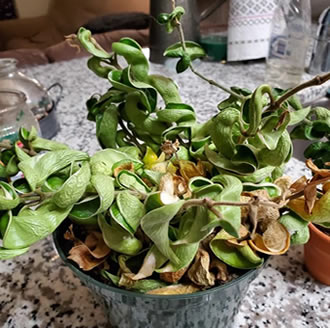
When overwatering is causing leaves to fall of your Hindu rope plant you will need to check the plant for root rot as outlined in a previous section above.
Review that information and follow the steps for identifying and treating your plant for root rot.
Hindu rope plant dropping leaves cause & cure 2: Insufficient light
Although a Hindu rope plant can survive in low light it will not fair well if given seriously reduced light.
Just as too much light can negatively affect the foliage by turning the leaves yellow, as I covered above, too little light can negatively affect the foliage as well leading to a loss of leaves.
The optimum light for this plant is at least 4 hours of strong indirect light per day.
Less than this will lead to stunted growth, and even slower growth than the normal slow growth, and will eventually force the plant to shed leaves in an attempt to reserve its resources.
Moving your Hoya to a location that has a minimum of 4 hours of strong indirect light per day is advisable though you can also use a grow light to make up for any deficiencies the plant is getting from its environment.
Hindu rope plant dropping leaves cause & cure 3: Temperature stress
The Hindu rope plant can tolerate a range of temperatures but sudden and consistent jumps and dips in temperature will usually lead to the plant losing leaves.
Avoid placing your Hoya carnosa compacta wax plant close to areas that experience drafts, such as doors that lead outside.
The changes in temperature from doors leading outside can negatively affect the plant. Leaving the plant close to freezer and refrigerator doors can have the same effect.
Equally, you should avoid placing the plant near heating vents or radiators for the same reason.
As a rule-of-thumb avoid putting your plant in any area that experiences swings in temperatures.
Refrigerators, coolers, outside facing doors, heaters HVAC vents etc., can cause sudden spikes or drops in temperature and so are places best avoided when positioning any hoya houseplants.
Hindu rope plant dropping leaves cause & cure 4: Low of humidity
Although a less likely cause for leaf loss, I have seen very low humidity levels be responsible for Hindu rope plant foliage loss in the past.
Be sure the plant’s localized environment, the small area directly around the plant, is at least at 40% humidity though higher is better.
You can safely create an environment with up to 60% humidity.
If the leaf loss is due to humidity issues then you should not take a chance using traditional methods for increasing humidity and instead use a modern cheap plant humidifier like this.
Causes & fixes for a Hindu rope plant shriveling with wrinkled leaves
Winkled leaves on a Hindu rope plant are almost always a sign of dehydration.
This is always due to a poor watering routine.
The 2 causes for wrinkles hoya leaves
The 2 causes for a shriveled Hindu rope plant and wrinkled leaves are:
- Underwatering.
- Overwatering.
In most cases a shriveled plant with wrinkled leaves is actually due to overwatering rather than underwatering even though the cause is dehydration.
However, let’s lock at underwatering first.
Hindu rope plant wrinkled leaves cause & cure 1: Underwatering
It is obvious that if you underwater a plant it will become dehydrated.
It is usual to have to water a Hoya rope plant every 2 – 3 weeks when it is grown in a typical American home.
With normal household temperatures of about 70°F this plant should not need watered any more than this.
If you have only been watering your plant once per month or less then the plant is likely not getting enough water.
Check the soil moisture level at the bottom of the pot. If the soil is completely dry then the plant likely needs watered.
With succulents and semi-succulents I always suggest houseplant owners check the roots of their plants for potential root rot unless they are 100% certain the plant has been underwatered.
Removing the plant from its pot and visually examining the roots will cause no harm to the plant. However, misdiagnosing it when it does indeed have root rot could mean you lose the small window for treatment leading to the eventual loss of the plant.
Don’t take the chance … check the roots of the plant!
Because the Hindu rope plant is a semi-succulent that requires much less water than most other common houseplants it is less likely that underwatering will be the cause of your shriveling plant.
It is much more likely due to overwatering.
Hindu rope plant wrinkled leaves cause & cure 2: Overwatering
As I covered in a previous section of this article, overwatering is extremely dangerous for a Hindu rope plant.
It leads to root rot, which is lethal for the plant.
If you have been watering your Hindu rope plant more than twice per week then you have almost certainly been overwatering the plant.
In some instances even once every 2 weeks is too much.
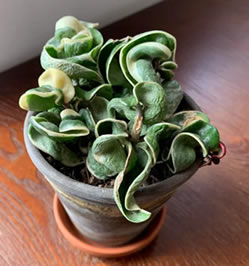
You must stop watering the plant immediately and inspect its rootball for damage.
If you find rot in the roots you must remove all mushy, dead roots completely and repot the plant in a new pot with fresh soil.
Follow the instructions given above in a previous section for details on how to do this.
Causes & fixes for a Hindu rope plant with dry leaves
Dry leaves on a Hindu rope plant are a result of dehydration.
All the reasons highlighted in the above section pertaining to shriveled and wrinkled leaves apply to a Hindu rope plant that has dry leaves.
The fixes are also the same.
The 2 causes for dry hoya leaves
To reiterate the 2 potential causes of dry leaves on a Hindu rope plant:
- Underwatering.
- Overwatering.
Read the section above outlining how to treat wrinkles leaves.
Causes & fixes for Hindu rope plant not blooming
There can be 4 reasons your Hindu rope plant is not blooming though the most likely caused are either lack of light or the fact that plant simply has not reached enough maturity to flower.
The causes for lack of blooms on a hoya plant
The 4 potential causes behind your Hindu rope plant is not blooming:
- An immature plant.
- Low light.
- Incorrect soil.
- Lack of nutrients.
Before you launch into an investigation for why your Hindu rope plant is not blooming ask yourself what age the plant is.
A Hindu rope plant must mature before it can bloom.
Though most Hindu rope plants will start to bloom after 3 – 5 years it can take up to 7 years for the plant to mature enough to be able to produce flowers.
If you have a plant that is older than 3 years and it has not yet bloomed there are 3 possible causes.
These are:
- Insufficient light.
- Incorrect soil.
- Lack of nutrients.
Hindu rope not flowering cause & cure 1: Insufficient light
Less than 4 hours of strong indirect light per day will mean your Hoya carnosa compacta wax plant never blooms.

Be sure you have placed it in an optimum location away from direct light but that is bright with indirect light.
You can use a grow light to give the plant extra help during the growing season.
Hindu rope not flowering cause & cure 2: Incorrect soil
Be sure your Hoya carnosa is growing in the correct type of soil, as outlined earlier in this article.
Using the wrong type of soil can mean the plant never gets a chance to bloom as the it will need all available resources just to grow new foliage.
Lack of proper airflow in the soil can also greatly restrict the plant’s ability to bloom, hence the need for the specific type of soil previously mentioned.
Review the above sections for the proper soil mixture to use with your Hindu rope plant.
Hindu rope not flowering cause & cure 3: Lack of nutrients
Similar to incorrect soil, a lack of the correct nutrients and minerals in the soil will restrict the Hindu rope plant from growing.
A low nutrient count in the soil, especially low levels of nitrogen, will mean the plant does not have enough available resources to produce flowers.
A key to encouraging the plant to bloom is to use a nitrogen rich fertilizer twice per week during growing season, but only make it up to half strength.
Doing this will not only encourage the plant to bloom but it will also help it to grow faster.
You can also use a regular succulent feed on Hoya carnosa though you may want to add some crushed coffee grounds to the mix to help increase soil nitrogen levels.
You may want to read our article how to grow Hindu rope plant for additional information on avoiding future problems with your Hindu rope plant.

